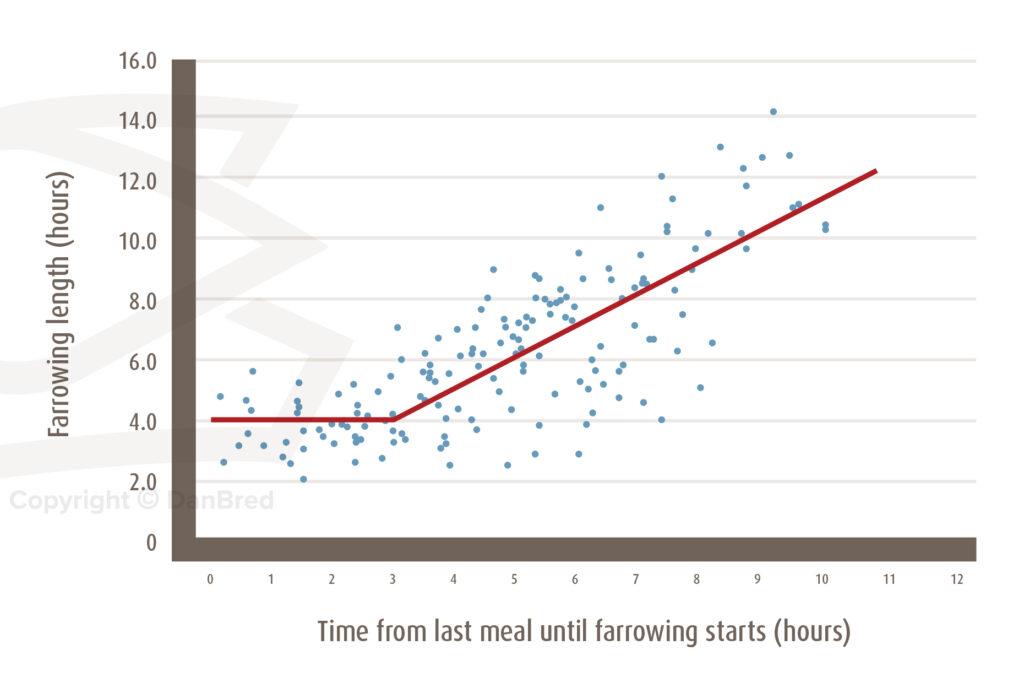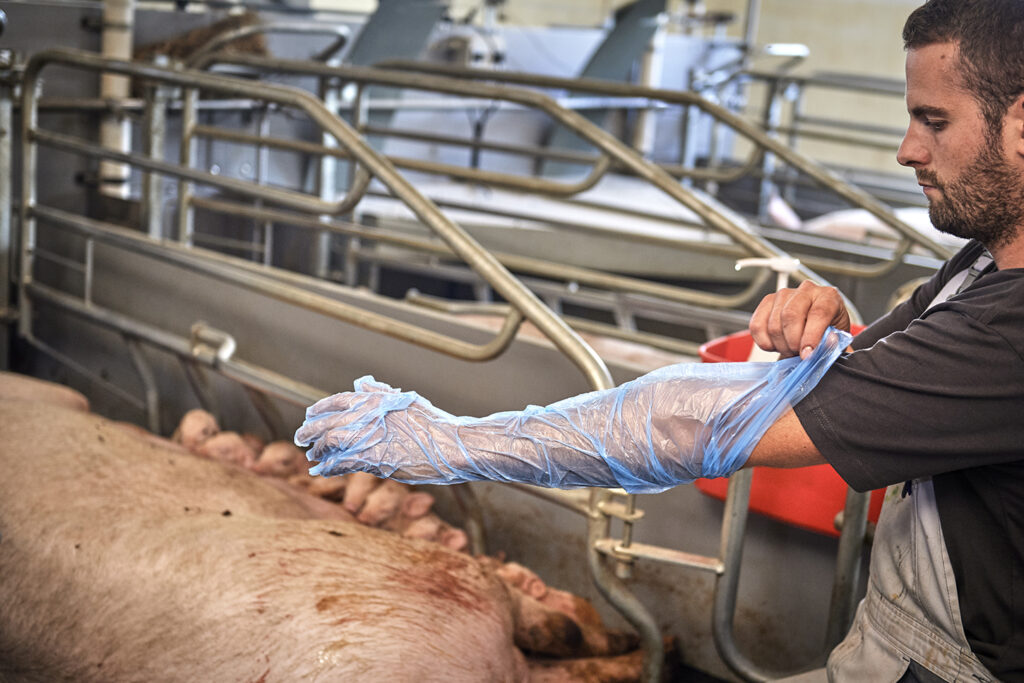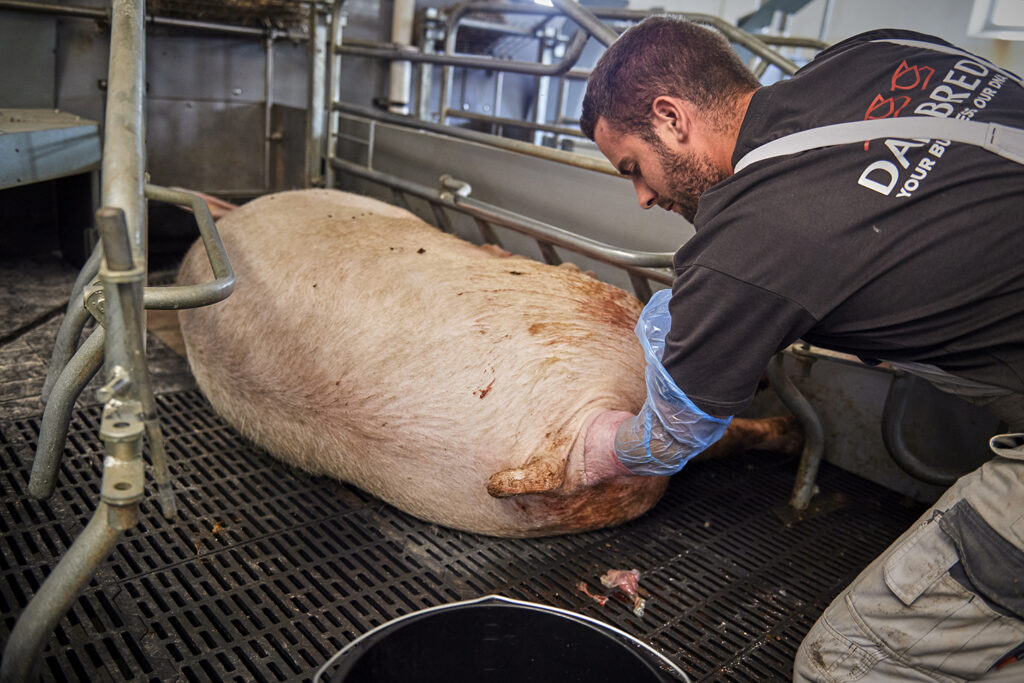Farrowing – Procedures for success
Content
How to ensure a successful farrowing
Capturing the immense production potential of the DanBred sow relies on fundamentally sound and proven management practices.
Correct procedures ensure success at farrowing
The successful management of large litters from hyper prolific DanBred females is reliant on the careful day 1 management of piglets. Capturing the immense production potential of the DanBred sow depends on the implementation of fundamentally sound and proven management practices to ultimately wean and market high value animals.
Successful management at the time of farrowing
Studies have established that several factors affect the success rate within the farrowing unit. The average farrowing time is 4-7 hours- this time span is not affected by litter size as big litters will be born with shorter intervals than small litters. The energy demand for producing a large litter is higher, therefore feeding in late gestation is critical with hyper prolific sows (DPRC, 2017).
The duration of farrowing has been shown to be closely linked to the sow’s energy status. Low-energy status at the onset farrowing negatively affects the farrowing process (Theil et al., 2017). Furthermore, the duration of the farrowing is negatively correlated with the risk of piglet losses, as the sow does not eat during farrowing. Feeding 3 to 4 times a day when the sows enter the farrowing unit will help to improve energy status and increase the success rate of farrowing (Feyera, 2018). Because of these factors, being able to recognise the onset of farrowing and acting accordingly is of great importance.
The observation and recording of sows that are farrowing is important- in particular you should take note of the birth interval between each piglet, as this is a big indicator of how the process is going.

The birth interval between the first 4 piglets is 40 minutes (on average), and the first 4 piglets should be born within 2 hours. After the 4th piglet, the average birth interval decreases to around 20 minutes- the 5th piglet should then be born within the hour. (DPRC, 2017). If this is not the case, intervention should be considered.
Monitored or attended farrowings has a tremendously positive effect on piglet survivability. DanBred highly recommends the observation of farrowing sows every 20 – 30 minutes. Farrowing assistance should begin if the birth interval exceeds 1 hour (Thorup et al., 2009).
Red eyes and underline and an increased breathing rate are all possible signs of a sow needing assistance.
As performing farrowing assistance (i.e. a manual examination) is an invasive procedure for the sow, hygiene and technique is of great importance.
The period following farrowing assistance is when the sow should be left to rest but kept under observation- it might necessary to repeat assistance (DPRC, 2017).
Important steps for the management of a successful farrowing



 Prepare for farrowings when the sows has entered the farrowing unit. Be aware of hygiene in the pens and clean behind the sows regularly. Prepare the piglet area – include heat lamp/floor heating.
Prepare for farrowings when the sows has entered the farrowing unit. Be aware of hygiene in the pens and clean behind the sows regularly. Prepare the piglet area – include heat lamp/floor heating.
Early signs of farrowing
- Swelling of the vulva
- Restless sows
- Nest-building behaviour
- Milk expressed from teats
Once milk let-down in seen, expect farrowing to start within 12 hours
Check the farrowing sows
- At the onset of farrowing, sows should be checked every 20 – 30 minutes, or at least once an hour (at minimum) during a 24-hour period.
- Make note of the time of birth for each piglet
- The first 4 piglets should be delivered within 2 hours
- Following piglets should be delivered with an interval not exceeding 60 minutes
Farrowing assistance
Signs of sows needing farrowing assistance include:
- Farrowing seems to have stopped
- Not passing a piglet within the above mentioned time span
- Red eyes and underline, and/or an increased breathing rate
Initiate farrowing assistance by following this procedure:
- Remove any equipment behind the sow to decrease the risk of work-related injuries
- Wash the sow with mild soap and rinse with plenty of clean water
- Put on a sterile glove, apply lubricant and pull up the glove sleeve
- Carefully introduce the arm by keeping the thumb and fingers together in a cone shape (note, fingernails should be short so as not to tear the sow):
- If sow is lying on her right side use the right arm.
- If on her left use the left arm.
- Grip the piglet around the hind legs or around neck or chin
- Pull the pig out in one even motion
- Make sure the pig’s airway is clear – rub the piglet gently but with firm pressure
- Dry the piglet and place it next to the udder
- Help out all piglets that are within reach
After assistance
- Leave the sow and piglets to rest but continue observation until farrowing has finished (watch for the placenta to pass)
- If the farrowing has not re-initiated within an hour repeat farrowing assistance
References
Danish Pig Research Centre (DPRC) (2017): Faringsforløb. SEGES Videncenter for Svineproduktion. Retrieved 16/02/19 https://svineproduktion.dk/viden/i-stalden/management/faring/faringsforloeb_ny
Danish Pig Research Centre (DPRC) (2018): H6 -Fødselshjælp. Manual om repromanagement. SEGES Videncenter for Svineproduktion. Retrieved 03/02/19 https://svineproduktion.dk/Viden/I-stalden/Management/Manualer/Repro
Feyera, T.; Pedersen, T.F.; Krogh, U.; Foldager, L.; Theil, P.K. (2018): Impact of sow energy status during farrowing on farrowing kinetics, frequency of stillborn piglets, and farrowing assistance. J Anim Sci. 96(6):2320-2331
Theil, P.K. (2017) Flere fodringer til soen giver færre dødfødte grise. Aarhus Universitet. Retrieved 21-02-2019. http://dca.au.dk/aktuelt/nyheder/vis/artikel/doedfoedte-grise-kan-reduceres-markant-via-fodring/
Thorup, F.; Herskind, A.M.; Hansen, E.M.; Musse, S.L.; Nielsen, J.P.; Schmid, M.H. (2009): Faringsforløb hos frugtbare danske søer – SEGES Svineproduktion. Meddelelse nr. 839. Videncenter for Svineproduktion, Den rullende afprøvning.




